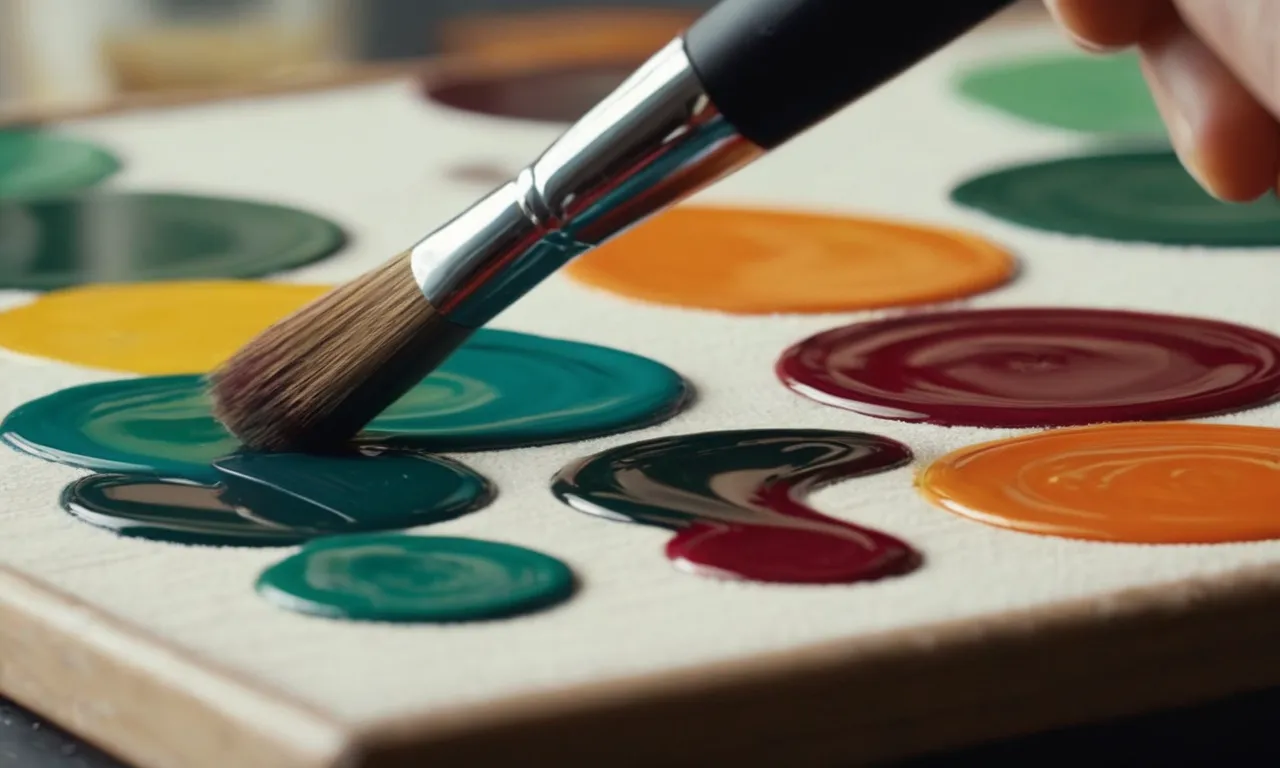How To Make Acrylic Paint Smooth: The Complete Guide
Whether you’re a beginner painter or a seasoned artist, achieving a smooth acrylic paint finish can be tricky. The texture and consistency of acrylic paint is naturally thick and dense. However, with the right techniques and tools, you can give your acrylic paintings a seamless, professional-looking surface.
If you’re short on time, here’s a quick answer to your question: Thinning your acrylic paints with water or acrylic medium and applying multiple thin layers will help create a smooth, even coat of paint.
Using soft bristle brushes and painting on primed, fine-toothed canvas can also improve the finish.
In this comprehensive guide, we’ll walk through everything you need to know to get a flawless, smooth acrylic paint surface, from how to thin and apply the paint properly to choosing the right canvas and brushes.
Thin Your Acrylic Paint
One of the key factors in achieving a smooth finish with acrylic paint is to ensure that it is properly thinned. Here are some tips on how to thin your acrylic paint:
Add water or acrylic medium
Water can be used to thin down acrylic paint, especially if you are looking for a more transparent or watercolor-like effect. Adding a few drops of water to your paint can help make it flow more smoothly on your canvas.
However, be careful not to add too much water, as it can dilute the pigments and affect the color intensity.
An alternative to using water is to use an acrylic medium, which is specifically designed to thin acrylic paint without affecting its color or consistency. Acrylic mediums come in different viscosities, such as gel or fluid, and can be mixed with the paint to achieve the desired consistency.
Test consistency on palette
Before applying the thinned paint to your canvas, it is important to test the consistency on a palette or a scrap piece of paper. This will allow you to assess whether the paint is too thick or too thin and make any necessary adjustments.
To test the consistency, dip the tip of your brush into the thinned paint and then lift it. The paint should flow off the brush smoothly and evenly, without any clumps or streaks. If the paint is too thick, add more water or acrylic medium.
If it is too thin, add a small amount of undiluted paint to thicken it.
Thin in stages
When thinning your acrylic paint, it is best to do it in stages rather than adding a large amount of water or medium all at once. This will allow you to have better control over the consistency and prevent over-thinning.
Start by adding a small amount of water or medium to your paint and mix it well. If the paint is still too thick, gradually add more and mix until you reach the desired consistency. Remember to test the paint on a palette after each addition to ensure that it is not over-thinned.
By following these tips and experimenting with different ratios of water or acrylic medium, you can achieve a smooth and even application of acrylic paint on your canvas.
Apply Multiple Thin Layers
When it comes to making acrylic paint smooth, applying multiple thin layers is key. By building up the paint gradually, you can achieve a smoother and more even finish. This technique allows for better control over the application of the paint and helps to minimize brushstrokes.
Build up paint gradually
Instead of applying a thick layer of paint all at once, it is recommended to build up the paint gradually. Start with a thin layer and allow it to dry before applying the next layer. This approach allows each layer to adhere properly to the surface and prevents the paint from cracking or peeling over time.
Allow each layer to dry first
It is important to allow each layer of paint to dry completely before applying the next one. This ensures that the previous layer has had enough time to cure and prevents any mixing or smudging of colors. Patience is key when it comes to achieving a smooth finish with acrylic paint.
Sand lightly between coats
To further enhance the smoothness of your acrylic paint, consider lightly sanding between coats. Using a fine-grit sandpaper or sanding sponge, gently go over the surface after each layer has dried. This helps to smooth out any imperfections or brushstrokes, resulting in a more polished look.
Remember, the goal is to create a smooth and seamless finish with your acrylic paint. By applying multiple thin layers, allowing each layer to dry, and lightly sanding between coats, you can achieve professional-looking results. Experiment with these techniques and don’t be afraid to get creative!
Use Quality Soft Bristle Brushes
When it comes to making your acrylic paint smooth, using the right brushes can make a significant difference. One of the key factors to consider is the bristle type. It is essential to avoid using stiff hog bristle brushes as they can leave visible brushstrokes on your painting surface.
These brushes are better suited for oil painting, where the texture is desired.
Avoid stiff hog bristle brushes
Stiff hog bristle brushes are made from the coarse hair of hogs, which makes them ideal for oil painting. However, when used with acrylic paints, they tend to leave visible brushstrokes and can make the paint appear rough.
So, it is best to steer clear of these brushes when aiming for a smooth finish in your acrylic paint.
Choose soft synthetic or sable hair brushes
To achieve a smooth and even application of acrylic paint, opt for soft synthetic or sable hair brushes. These brushes have finer bristles that allow for better control and smoother strokes. Synthetic brushes are more affordable and durable, while sable hair brushes are known for their excellent paint retention and softness.
Both options can help you achieve a smoother finish in your acrylic paintings.
Keep brushes damp while painting
Another useful tip for achieving a smooth application of acrylic paint is to keep your brushes slightly damp while painting. Acrylic paints can dry quickly, which can sometimes result in visible brushstrokes.
By keeping your brushes slightly damp, you can extend the drying time of the paint and allow it to blend more seamlessly on the canvas. This technique helps in achieving a smoother and more uniform finish.
Remember, the quality of your brushes plays a significant role in the final outcome of your acrylic painting. By choosing soft bristle brushes and keeping them damp while painting, you can make the paint application smoother and achieve a more professional-looking result.
Paint on Primed, Fine-Toothed Canvas
When it comes to making acrylic paint smooth, using the right surface is crucial. One of the best surfaces to work on is a primed, fine-toothed canvas. This type of canvas provides a smooth and even texture, allowing the paint to glide on effortlessly.
Here are a few reasons why painting on a primed, fine-toothed canvas can yield excellent results.
Primer creates a smooth base layer
Priming your canvas before painting is essential for achieving a smooth finish. A primer creates a barrier between the canvas and the paint, preventing the paint from being absorbed too quickly. This allows you to have better control over the paint application and ensures that the colors remain vibrant.
Choose a high-quality acrylic primer that is specifically designed for canvas to ensure the best results.
Tight canvas weave prevents paint sinking in
A fine-toothed canvas has a tighter weave compared to regular canvas. This tight weave helps prevent the paint from sinking into the fabric, resulting in a smoother surface. When the paint sits on top of the canvas instead of being absorbed, it dries more evenly and retains its original color intensity.
This is particularly important when working with transparent or translucent colors that require a smooth surface to showcase their true vibrancy.
Sand canvas lightly before priming
Before applying the primer, it’s a good idea to lightly sand the canvas surface. This helps smooth out any rough spots or imperfections, ensuring that the primer adheres evenly. Use a fine-grit sandpaper or sanding block and gently rub it in circular motions over the canvas.
Be careful not to oversand, as this can damage the canvas. After sanding, wipe away any dust or debris with a clean, dry cloth before applying the primer.
By painting on a primed, fine-toothed canvas, you’ll have a smooth and professional-looking finish for your acrylic paintings. Remember to choose a high-quality primer, take your time to sand the canvas lightly, and enjoy the process of creating beautiful artworks.
Maintain Proper Painting Technique
When it comes to making acrylic paint smooth, proper painting technique is crucial. By following a few simple guidelines, you can achieve a flawless finish on your canvas.
Apply in direction of canvas grain
One important tip is to always apply your acrylic paint in the direction of the canvas grain. This helps to minimize brush strokes and create a smoother appearance. The canvas grain refers to the texture or pattern of the canvas surface.
By brushing in the same direction as the grain, you can achieve a more uniform and even application of paint.
Keep paint strokes consistent
Consistency is key when it comes to achieving a smooth finish with acrylic paint. Make sure to keep your paint strokes consistent throughout the entire painting process. Avoid switching between short and long strokes, as this can create an uneven texture on the canvas.
By maintaining a steady and uniform stroke, you can create a more polished and professional look.
Work quickly to maintain wet edge
Acrylic paint dries quickly, so it’s important to work efficiently to maintain a wet edge. This means that you should try to complete each section or area of your painting before the paint has a chance to dry.
If the paint does dry before you are finished, it can be difficult to blend or smooth out any brush strokes. To prevent this, work in small sections and keep a spray bottle of water handy to mist the paint and keep it moist.
Maintaining proper painting technique is essential for achieving a smooth finish with acrylic paint. By applying the paint in the direction of the canvas grain, keeping your paint strokes consistent, and working quickly to maintain a wet edge, you can create a polished and professional look in your artwork.
Consider Using Acrylic Mediums
If you want to make your acrylic paint smooth and achieve a professional-looking finish, using acrylic mediums can greatly help. These mediums are specially formulated additives that can alter the properties of acrylic paint, such as its viscosity and drying time.
There are different types of acrylic mediums available, each serving a specific purpose in improving the smoothness of your paint.
Flow Improver Decreases Brush Strokes
One common issue with acrylic paint is the presence of visible brush strokes on the surface. To minimize this effect and create a smoother finish, you can add a flow improver medium to your paint. This medium helps the paint flow more evenly, reducing the appearance of brush marks.
It allows the paint to spread easily, resulting in a smoother and more consistent application.
Retarder Slows Drying Time
Another challenge with acrylic paint is its fast drying time, which can sometimes limit your ability to blend colors or create smooth transitions. By using a retarder medium, you can slow down the drying time of the paint.
This gives you more time to work with the paint, allowing for better blending and smoother transitions between colors. It also helps prevent the paint from drying too quickly on your brush, which can lead to visible brush marks.
Gel/Paste Thickens Paint Viscosity
If you want to achieve a thicker paint consistency, adding a gel or paste medium to your acrylic paint can be beneficial. These mediums increase the viscosity of the paint, making it more opaque and allowing for better coverage.
This can be particularly useful when you want to create texture or impasto effects in your artwork. The increased thickness also helps in achieving a smoother finish by filling in any uneven areas on the surface.
When using acrylic mediums, it’s important to follow the manufacturer’s instructions and experiment with different ratios to achieve the desired effect. Additionally, make sure to thoroughly mix the medium with the paint to ensure proper incorporation.
By incorporating acrylic mediums into your painting process, you can enhance the smoothness of your acrylic paint and take your artwork to the next level.
Conclusion
Achieving a smooth, professional finish with acrylics can be a challenge, but with some effort and the right techniques, you can create paintings with a flawless surface. By thinning your paint properly, applying multiple thin layers, using soft bristle brushes, and painting on primed, fine-toothed canvas, you can get your acrylics looking as sleek as oil.
Don’t be intimidated by the fast drying time – with a little practice your acrylic paintings will have the same polished look as any medium. Just take your time, have patience, and apply these tips as you work.
Before you know it, you’ll be creating show-stopping acrylic pieces with a glass-like surface.







